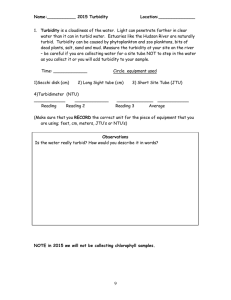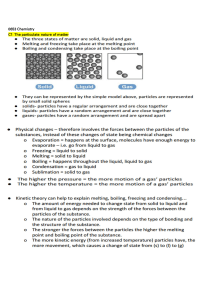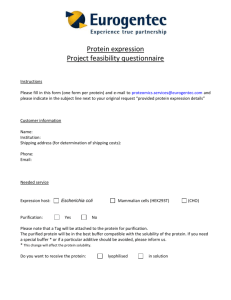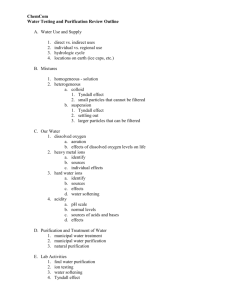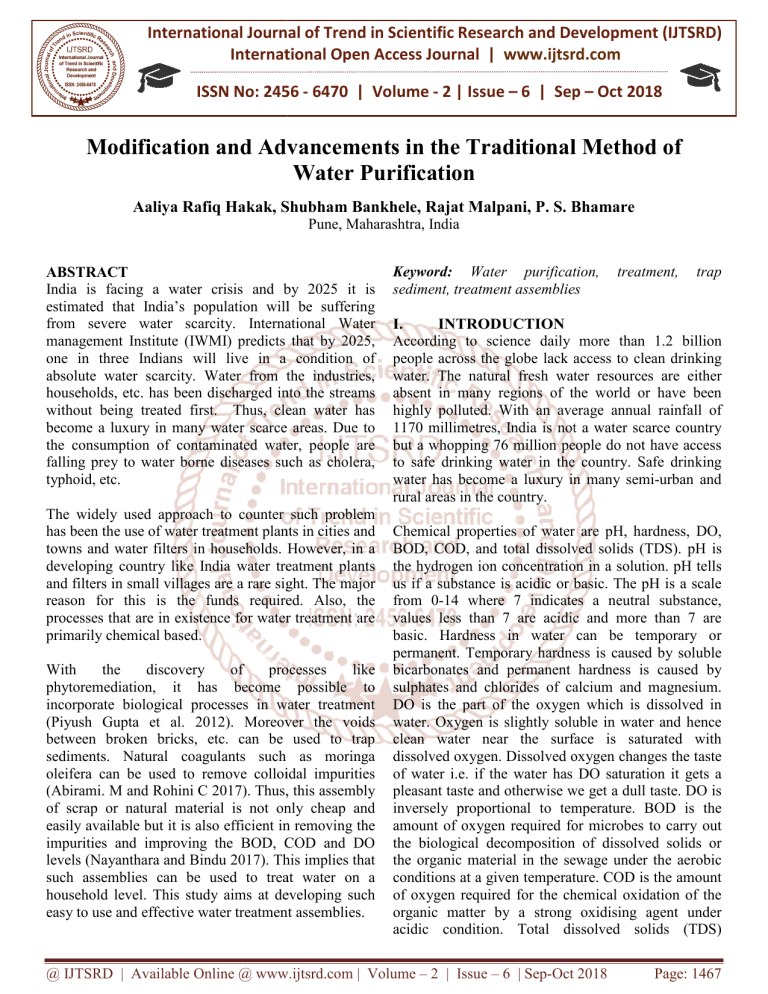
International Journal of Trend in Scientific Research and Development (IJTSRD) International Open Access Journal | www.ijtsrd.com ISSN No: 2456 - 6470 | Volume - 2 | Issue – 6 | Sep – Oct 2018 Modification and Advancements in the Traditional Method of o Water Purification Aaliya Rafiq Hakak, Shubham Bankhele, Rajat Malpani, P. S. Bhamare Pune, Maharashtra, India ABSTRACT India is facing a water crisis and by 2025 it is estimated that India’s population will be suffering from severe water scarcity. International Water management Institute (IWMI) predicts that by 2025, one in three Indians will live in a condition of absolute water scarcity. Water from the industries, households, etc. has been discharged into the streams without being treated first. Thus, clean water has become a luxury in many water scarce areas. Due to the consumption tion of contaminated water, people are falling prey to water borne diseases such as cholera, typhoid, etc. The widely used approach to counter such problem has been the use of water treatment plants in cities and towns and water filters in households. Ho However, in a developing country like India water treatment plants and filters in small villages are a rare sight. The major reason for this is the funds required. Also, the processes that are in existence for water treatment are primarily chemical based. With the discovery of processes like phytoremediation, it has become possible to incorporate biological processes in water treatment (Piyush Gupta et al. 2012). Moreover the voids between broken bricks, etc. can be used to trap sediments. Natural coagulantss such as moringa oleifera can be used to remove colloidal impurities (Abirami. M and Rohini C 2017). Thus, this assembly of scrap or natural material is not only cheap and easily available but it is also efficient in removing the impurities and improving the BOD, COD and DO levels (Nayanthara and Bindu 2017). This implies that such assemblies can be used to treat water on a household level. This study aims at developing such easy to use and effective water treatment assemblies. Keyword: Water purification, sediment, treatment assemblies treatment, trap I. INTRODUCTION According to science daily more than 1.2 billion people across the globe lack access to clean drinking water. The natural fresh water resources are either absent in many regions of the world or have been highly polluted. With an average annual rainfall of 1170 millimetres, India is not a water scarce country but a whopping 76 million people do not have access to safe drinking water in the country. Safe drinking water has become a luxury ury in many semi-urban semi and rural areas in the country. Chemical properties of water are pH, hardness, DO, BOD, COD, and total dissolved solids (TDS). pH is the hydrogen ion concentration in a solution. pH tells us if a substance is acidic or basic. The pH p is a scale from 0-14 14 where 7 indicates a neutral substance, values less than 7 are acidic and more than 7 are basic. Hardness in water can be temporary or permanent. Temporary hardness is caused by soluble bicarbonates and permanent hardness is caused by sulphates and chlorides of calcium and magnesium. DO is the part of the oxygen which is dissolved in water. Oxygen is slightly soluble in water and hence clean water near the surface is saturated with dissolved oxygen. Dissolved oxygen changes the taste off water i.e. if the water has DO saturation it gets a pleasant taste and otherwise we get a dull taste. DO is inversely proportional to temperature. BOD is the amount of oxygen required for microbes to carry out the biological decomposition of dissolved solids so or the organic material in the sewage under the aerobic conditions at a given temperature. COD is the amount of oxygen required for the chemical oxidation of the organic matter by a strong oxidising agent under acidic condition. Total dissolved solids (TDS) @ IJTSRD | Available Online @ www.ijtsrd.com | Volume – 2 | Issue – 6 | Sep-Oct Oct 2018 Page: 1467 International Journal of Trend in Scientific Research and Development (IJTSRD) ISSN: 2456-6470 2456 includes These include inorganic salts mainly the chlorides, sulphates and the bicarbonates of calcium, magnesium, potassium and sodium. Physical properties of water are colour, odour, taste, and turbidity. Pure natural water does not have any colour. ur. It is imparted by the presence of organic and inorganic matter. Natural water is odourless and tasteless but in case of stored water, taste and odour gets developed. It is the suspended matter like mud, clay, algae and microbes that make the water turb turbid II. LITERATURE REVIEW Abirami. M and Rohini.C (2017) has worked on a comparative study on the treatment of turbid water using Moringa Oleifera and alum as coagulants. The study aims to add fine powder of Mornings Oleifera seeds as a natural coagulant in treating eating the turbid water and the same water will be treated by the alum. The jar test is carried out to find the turbidity of the water sample. The results showed that the turbidity removed by the alum and Moringa Oleifera was about 70% and 75% respectively.. It is highly recommended. O. S. Nayanthara and A. G. Bindu (2017) have reviewed the various attempts used to recycle grey water. Introducing the methods tof treatment as physical (filtration, disinfection, etc.), chemical (membrane bioreactor (MBR), constructed wetlands (CW) etc.) and biological, the authors ors have laid stress on hydroponics i.e., the biological method. Eichornia crassipes (water hyacinth) and Pistia stratiotes (water lettuce) have been taken under consideration. With reference to the treatment system it was observed that BOD removal was highest hest in duckweed system followed by Pistia and Algae at 95%, 93% and 25%, COD removals were 65% and 59% respectively for duckweed and pistia while COD increased in algal ponds by 56%. Removal of TDS was 70% for pistia, 15% for duckweed and 9% for algae. Pe Percentage reduction of turbidity for Eichornia crassipes were 85.26% and 87.05% while pistia stratiotes were 92.70% and 93. 69% respectively. It was therefore concluded that eichornia crassipes and pistia stratiotes can be effectively used for removal of BO BOD, COD, nitrogen and phosphorous. Shweta Chauhan et al (2015) has carried the work to improve the quality of drinking water for Thatipur, Gwalior(MP) region with the use of the plant extracts of Moringa Oleifera, Arachis hypogae, Vinga unguiculata, Vinga mango and Zea mays. The leaves and seeds after drying, fine powder was prepared with the help of grinder. The treated sample were examined on the basis of appearance, taste, colour, pH, odour, and total microbial counts. Plant extract were added at the concentration oncentration of 0.01%, 0.1%, 0.2% and 0.3% in 100 ml of water sample. The results showed a significant decrease in the microbial counts to 92%, 95% of the heavy metals were also reduced in treated samples. This work concluded that the application of combined ed seeds and leaves of plant extracts can be used for water purification in developing countries to treat contaminated turbid water. Dr. Siva Panuganti and Kshama Awasti (2015) have studied the properties of the nine significant medicinal plants which were re used traditionally in the purification of water in this paper. This data on the plants has been collected from ancient manuscripts and electronic database (google scholar). This paper also states that a detailed scientific study on this aspect has not been een conducted. The various properties of the nine plants has been given in a tabulated form in this paper. Also various other methods mentioned in this paper are use of Alum in Water, Using cloth for filtering, Keeping Tortoises in open wells, Use of Moringa ga Seeds, etc. however these methods are limited for muddy water only. This study is focused on applying the same traditional methods on chemically contaminated water or waste water. Shaikh et al. (2015) has focussed on the reuse of grey water and calculated ted the efficiency of the same. 8 grey water samples from households in Pusad city were taken. These samples were passed through a five stage water treatment plant comprising of a storage tank, sedimentation tank, filter tank I and II and disinfection tank.. The water from the outlet of the assembly was tested for pH, hardness, chloride, turbidity, temperature, BOD, TSS, TDS and colour. Due to the considerable decrease in pH, hardness, turbidity, TSS and TDS, it was concluded that the assembly can be used as a viable alternative to conventional water treatment. The additional benefits that were concluded are low energy demand, less operation and maintenance cost, lower load on fresh water, less strain on septic tank, highly effective purification and ground water ater recharge. A. Ambica and K. Venkatraman (2015) have worked on the idea of integrating the natural wetlands into the infrastructure of a city for the treatment of wastewater @ IJTSRD | Available Online @ www.ijtsrd.com | Volume – 2 | Issue – 6 | Sep-Oct Oct 2018 Page: 1468 International Journal of Trend in Scientific Research and Development (IJTSRD) ISSN: 2456-6470 2456 generated in it. They have also observed the challenges faced in integrating this his system. This paper is based on the concept on root zone treatment system, it working, various other factors such as quantity and quality of waste water as well as challenges of integrating this concept in the infrastructure. This paper also gives information mation on the vegetation required in the wetlands and also about the opportunities in wetland wastewater system. It also emphasizes on the important points of maintenance of these wetlands and its efficient functioning. biodegradation, bioconversions, biotransformations of pollutants and conversion into non-toxic non by-products and nutrients in this paper. They have given basis and strengths of ecotechnology. They have also discussed the process of water treatment in this technology in detail and have also highlighted its advantages. In this paper they have also discussed in detail the biomechanisms of ecotechnological treatment systems. Also a brief comparison of various technologies for pollution elimination along with their results is also given. Sayali Joshi and Sandeep Joshi (2015) have stated various ecotechnological applications for the treatment of waste water. They have used techniques such as soil scape filter, hydrasch succession pond, stream ecosystem, green bridge technology, green lake technology, etc. the central idea is to use various aquatic plants and other organic materials in the treatment of waste water. It works on the principle that use of waste from one component as the food for the other component and in the process achieving the ultimate aim of purification of water. Piyush Gupta et al. (2012) has investigated the treatment of water by phyto remediation using water hyacinth, water lettuce and vetiver grass. Considerable decrease in BOD and COD was found in case of water hyacinth and water lettuce and decrease in TDS, heavy metals and hardness in case of vetiver grass. It was thus observed that the above floating plant system can prove to be economical and efficient to remove contaminants. Moa Megersa et al (2014) has used plant species to improve the drinking water quality regarding turbidity and microbial load. The results declare that the plant species have a potential to reduce the turbidity an and microbial load. It also showed that M. Oleifera can be used as primary coagulant. COD was reduced up up-to 96% after the purification by M. Oliefera. Disadvantage of using natural coagulant is that it can be effectively used for the high turbid water.The major jor limitation is the release of organic matter and nutrients to apply at large scale. It is concluded that plant species can be used for water purification in developing countries. Dr. Sandeep Joshi (2013) has stated that ecology is lost in the infrastructure cture and economic growth which needs to be reconsidered. He has undertaken a case study of Udaipurs’ ecological restoration of Ahar River. He has done a brief diagnosis of current pollution status in India and has also given an action plan to counter its effects. In this paper he has also highlighted the advantages of ecotechnology and natural systems in the treated of polluted water. He has given the project outcomes from the Ahar River project in graphical form. M. Pritchard et al (2009) has carried the work for water purification with the application of plant extracts. Water sample were collected from 5 shallow wells. Good quality seeds of M. Oleifera, J. Curcus, Guar Gum were individually grinded. The powder pow was then sieved through a 600 micron sieve. The solution was then prepared by adding 10gm of powder in 100 ml of distilled water. The treated water sample were examined on the basis of turbidity, pH, and coliform counts. It was observed that the turbidity turbid reduction was higher for more turbid water. pH of the water increased with the increase in in the dosage but it was in the acceptable range. K. A. Yongabi (2004) has investigated on the coagulative and disinfective ability of the seeds of M. Oleifera,, Jatropha curcus seeds, calyx of hibiscus and selerotium of pluerotus on waste water sample. The above material was first dried and then it was grinded separately. The results showed 90% reduction in bacterial load of water sample treated by M. Oleifera. It was observed that the pH of alum treated water decreased from neutrals to acidic but for plant extracts it was within the limits of WHO guidelines. Compared to the untreated water sample, all the plant extracts are between 60-90% 90% for the rural areas where whe there are no facilities for the treatment of drinking water. effective in purifying the waste water sample. Dr. Sandeep Joshi and Sayali Joshi (2013) have discussed the basics of ecological principles involving @ IJTSRD | Available Online @ www.ijtsrd.com | Volume – 2 | Issue – 6 | Sep-Oct Oct 2018 Page: 1469 International Journal of Trend in Scientific Research and Development (IJTSRD) ISSN: 2456-6470 2456 III. CONCLUSION From all the research papers we can conclude that plants can be used for effective water treatment in rural areas. They reduce BOD, COD COD, TSS and turbidity of water. Plants commonly used are M. Oleifera, J. Curcus, guar gum, water lettuce, duckweed, vetiver grass Arachis hypogae, Vinga unguiculata, Vinga mango and Zea mays mays. They also have some additional benefits like low energy demand and less maintenance. IV. REFERENCES 1. Abirami. M and Rohini. C (2017). A Comparative Study on the Treatment of Turbid Water Using Moringa Oleifera and Alum as Coagulants. International Conferencee on Emerging trends in Engineering, Science nce and Sustainable Technology. 2. O. S. Nayanathara and A. G. Bindu (2017). Effectiveness off Water Hyacinth And Water Lettuce For The Treatment Of Greywater. International conference on innovative research in science, technology and management. 3. Shweta Chauhan et.al. (2015). Purification of drinking water with application of natural extracts. Journal of globall biosciences, vol. 4, issue 1. 4. Shaikh et.al. (2015). Grey water Reuse: A sustainable solution of water crisi in Pusad City, Maharashtra, India. International Journal on recent and innovation trends in computing an and communication.Vol.3, issue 2. 5. Dr. Siva Panuganti and Kshama Awasthi (2015). Rediscovering Traditional Methods for Purification Of Water Using Important M Medicinal Plants. International Journal of Information Research rch and Review, Vol.2, Issue 9. 6. A. Ambica and K. Venkatraman (2015). Wetland wastewater treatment system for small city suburbs. Indian Journal of Science Sc and Technology, Vol8(32) 7. Sayali Joshi and Sandeep Joshi (2015). Ecotechnological applications for the control of lake pollution. International Journal of Information Research rch and Review Vol. 2, Issue 09 8. Moa Merges et.al. (2015). Use of indigenous plant species for drinking water treatment in developing devel countries. Journal of biodiversity and environmental nmental sciences. Vol5, No. 3. 9. Dr. Sandeep Joshi (2013). Ecological Processes To Remediate Polluted Rivers And Lakes: Economically Sustainable Solutions. International Conference on Water Cooperation & Conservation servation for Inclusive Growth 10. Dr. Sandeep Joshi and Sayali Joshi (2013). BioBio Mechanisms of Self - Purification Processes of Rivers and Lakes. International Conference on Water Cooperation & Conservation Con For Inclusive Growth 11. Piyush Gupta et. al. (2012). Treatment of Water Using Water Hyacinth, Water Lettuce and Vetiver Grass. ass. Resources and Environment. 12. M. Pritchard et.al. (2009). Potential of using plant extract for purification of shallow well water in Malawi. Physics and Chemistry of o the Earth, Elsevier, vol. 34. 13. K. A. Yongabi (2004). Studies on the potential use of medicinal plants and Macro fungi (Lower plants) in water and waste water purification. @ IJTSRD | Available Online @ www.ijtsrd.com | Volume – 2 | Issue – 6 | Sep-Oct Oct 2018 Page: 1470
